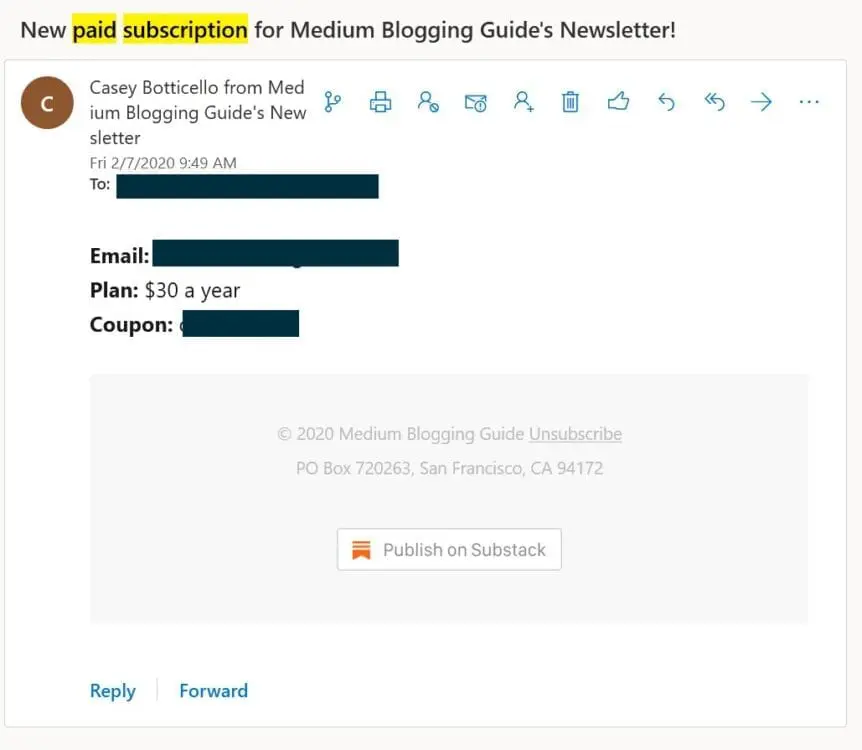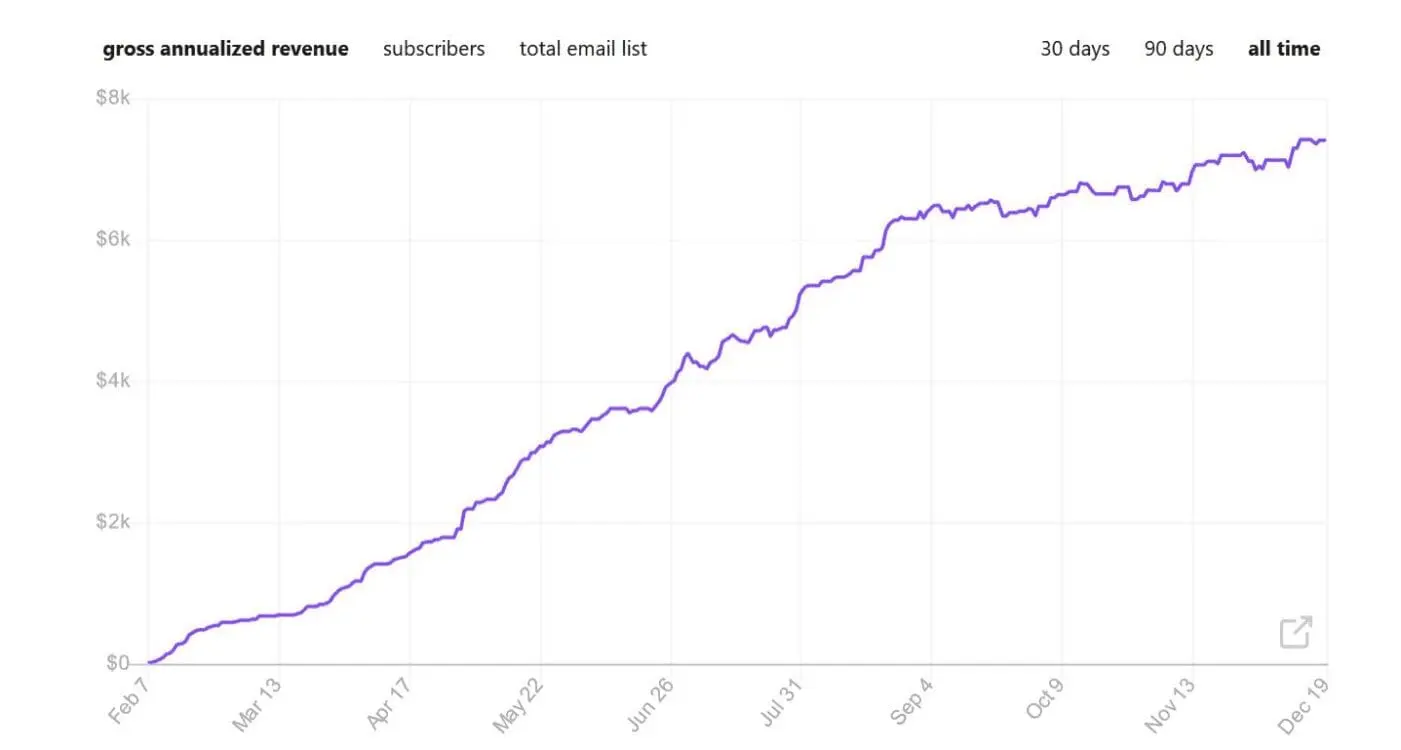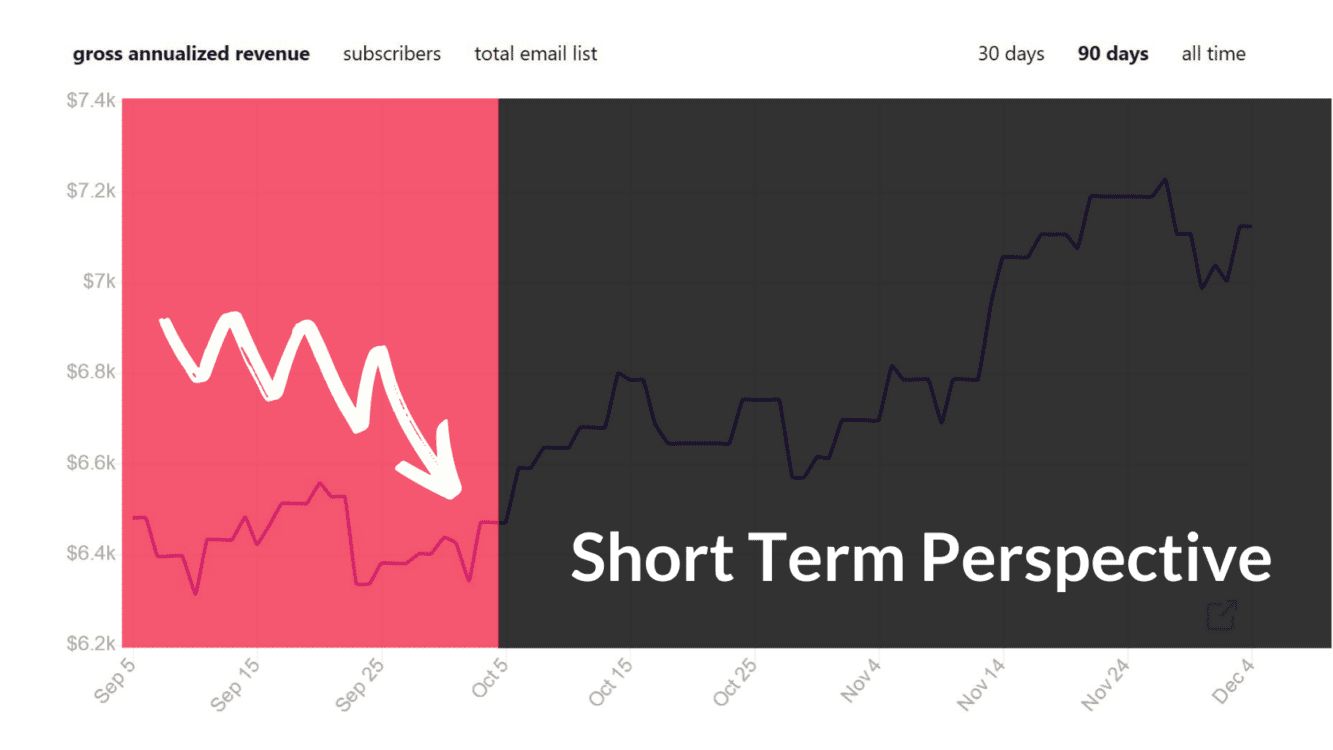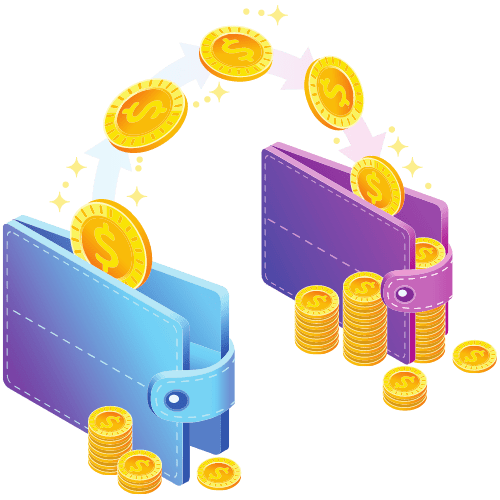Disclosure: Some of the links below are affiliate links, meaning that at no additional cost to you, I will receive a commission if you click through and make a purchase. Read our full affiliate disclosure here.
When I was building my first Substack newsletter, there were no third party resources available for newsletter creators. Getting my first 250 paid subscribers was hard! That's why I created the first Substack Course.
CASEY BOTTICELLO
Founder, Blogging Guide
Substack makes it simple for a writer to start an email newsletter that makes money from subscriptions. Substack provides web and newsletter publishing tools that are purpose-built for paid subscriptions.
In many ways, Substack has emerged as a major player in the digital publishing space, not through creating or inventing revolutionary ideas, but by simplifying existing concepts, and making them accessible to the average writer (and even users who would have never have identified as “writers” but want to monetize their ideas, opinions, and insights.
Newsletters have a long and rich history. Even subscription newsletters (where readers pay for access to someone’s newsletter) existed long before Substack. Ben Thompson’s, Stratechery, being one of the best examples.
But this previous generation of newsletters were created almost exclusively by:
- Tech savvy entrepreneurs who could easily build their own tech infrastructure;
- Subject matter experts, with traditional credentials;
- Writers who had already built up an established audience through traditional publishing channels.
Substack was unique in that it significantly lowered the barrier of entry into subscription digital publishing. Substack offered a content management system (CMS) built for publishing email newsletters, integrated payments through Stripe, and a website that can host free and subscriber-only content. None of these aspects were unique, but the integration of these three in a WYSIWYG platform was quite a unique offering.
As someone who writes about digital publishing, I was intrigued by Substack as both a game-changing platform (which I needed to investigate for my readers, many of which I anticipated would be eager to try out the platform) and as a new mechanism for monetizing my own content.
You can read a higher level review of Substack as a digital publishing platform, here. Below is an account of my personal experience using Substack, data from my newsletter, and tips for fellow Substack writers.
Creating Blogging Guide (My Substack Newsletter)
On January 1, 2020, as part of my New Year’s goal setting, I revisited a number of entrepreneurial ideas I had not pursued the previous year. I decided to create a subscription newsletter centered around digital publishing.
So I took a second look at Substack. Substack allows users to create a subscription based newsletter and blog hybrid, which intrigued me. I resolved to launch a Substack newsletter in the following weeks.
Later January of 2020, I officially launched my first Substack newsletter, called Blogging Guide.
I didn’t expect it to be immediately successful, but I had developed a decent following on several digital publishing platforms (most notably, on Medium) and thought that over the course of a year I might be able to reach 20 paying subscribers.
However, even this seemed ambitious. As most internet entrepreneurs can attest, getting strangers to pay for one off products is hard. Convincing them to pay for a subscription information product? That is very difficult.
So Blogging Guide was initially launched as a free newsletter. There was not even an option for subscribers to pay (monetization was off).
I had received a lot of positive comments and feedback during the 100% free sign up only period.
I enabled paid subscriptions for my Newsletter on February 3, 2020. At this point, my audience was still mostly those trying to master writing on Medium, so the paid newsletter launched under the name Medium Blogging Guide.
I set the price as low as Substack would let me ($5 per month or $30 per year) and on top of that, I offered a 50% discount to initial subscribers (so it actually cost $2.50 per month or $15 per year).
Even though this is a very low price point, I was worried few people (if any) would subscribe given that most writers already pay $5 per month or $50 per year for reading articles on Medium.
I thought that I would give it three months or so, and see if I could even get a single subscriber.
On February 7, 2020 (four days after enabling monetization), I received my first paid subscriber! I was stunned to receive the email notification:

I had only published one paid-subscriber-only post a few days earlier, and figured it would require at least a month of publishing/building a large enough back catalogue to get a reader to even consider subscribing.
This “Zero to One” moment was a real game changer. The newsletter concept worked, someone found value in my writing, and I could charge for content that was higher quality and more in depth.
Though still cautiously optimistic, I decided to dedicate more time to developing my Substack newsletter.
Substack Newsletter Data Analytics / Results
Over the next few months, subscribers continued to validate the concept. Blogging Guide reached 100 paid subscribers on April 20, 2020.

This was an amazing moment! I considered this the major milestone which validated the concept of my newsletter.
In the context of the “1000 True Fan Theory” I was now 10% of the way to reaching a sustainable passion economy based business.
For those not familiar, the 1000 True Fan Theory:
More than a decade ago, Wired editor Kevin Kelly wrote an essay called “1,000 True Fans,” predicting that the internet would allow large swaths of people to make a living off their creations, whether an artist, musician, author, or entrepreneur. Rather than pursuing widespread celebrity, he argued, creators only needed to engage a modest base of “true fans”—those who will “buy anything you produce”—to the tune of $100 per fan, per year (for a total annual income of $100,000). By embracing online networks, he believed creators could bypass traditional gatekeepers and middlemen, get paid directly by a smaller base of fans, and live comfortably off the spoils.
In December 2020, less than a year after I started my newsletter, I hit another big milestone, reaching 250 paid subscribers to Blogging Guide!
While I am a very goal oriented person, I usually don’t focus on short term goals. I try to measure (and predict) success in intervals of at least a year.
So as I approach the end of the first year of running a paid Substack newsletter, I thought I would provide some of my data, observations, and tips to help other writers.
I’ve written a few articles covering Substack writing tips, Substack earning potential, Substack formatting, and platform comparisons of Substack to rival platforms. However, this post is more detailed, and likely the most useful since it contains a better sample of data.
Having a longer-term outlook is useful for a number of reasons, but most importantly to me:
Evaluating success using a longer period of time (at least a year) allows me to stop worrying about misleading short term trends. These short term trends are often more a result of a lack of data, as opposed to an actual shift that I need to react to.
A good example of this (which many writers/indie creators can probably relate to) is obsessively checking your stats for your blog, articles, newsletter, or product sales.
While there is nothing inherently wrong with checking your stats often, there is a real risk of drawing flawed conclusions based on a limited set of data.
Take a look at the two charts below:


These two charts report the Gross Annualized Recurring Revenue from my Substack newsletter and writer community, Blogging Guide.
Both of these charts show some upward growth, but it would appear any growth that it is occurring, is quite gradual (with a number of drops and financial setbacks along the way).
This is especially apparent for the month of September, which, at the time, seemed dissapointing:

While I was tempted to make changes, I stuck with my long term content calendar, and I waited a few more months, to allow myself the time to properly contextualize the data.
However, even when viewing the gross annualized revenue all-time chart (long-term perspective), this period of time does not really explain much, when viewed out of context (although the trend looks somewhat better).

Take a look at the all-time graph (just short of one year’s progress):

When you “zoom out” and examine the broader trend, it becomes clear that:
- The yellow highlighted period of time (seen in the previous graphs) was not actually that unique in the newsletter’s overall growth trend. It was also not a period of “failure.” Rather it was a fairly arbitrary fluctuation caused by a lack of data.
- Any decisions made during this period (to change price, increase content production, etc.) would have likely been predicated on a skewed data sample.
- Substack’s graph depicting gross annualized revenue can easily be influenced by a small group of users, who are monthly subscribers, with a relatively high churn rate. This is true for my newsletter too, even though 90%+ of my paid subscribers at any given time are annual subscribers. This volatility would be even more exaggerated in a newsletter with fewer annual subscribers.
Lessons Learned in the First Year of Publishing My Paid Substack Newsletter
1. Choose Your Newsletter Name Carefully
Picking a good name is essential to creating a successful Substack newsletter. Ideally, your Substack publication will meets most of the following tips:
- Keep the name short — Generally, the shorter the name, the better. It is also ideal to keep your publication name between 1–3 words.
- Keep the name simple — I would suggest keeping the newsletter name simple.
- Try to pick a name with an available domain name — This suggestion is optional. But if you want to have the potential to build a brand beyond your Substack newsletter.
As you will notice from the Substack leaderboard, most of the top publications follow these basic rules.

2. Substack Has Very High Domain Authority
For me personally, choosing the name “Blogging Guide” made sense as it was concise, easy to spell, and I had already started building a brand around that keyword search phrase. This leads me to the next lesson that I learned from Substack, which is that Substack has high Domain Authority (DA), and writers need to view each newsletter as both a new issue and a static blog post.
One of the most overlooked aspects of Substack is the fact that your newsletter doubles as a static blog post.
Why does this matter?
Normally, the ROI on any individual newsletter issue is relatively low. However, when each issue doubles as a blog post with high domain authority, this significantly increases the value of an individual post. Because far more people will end up seeing it through search engine traffic, there is an additional incentive to create high quality content (as opposed to churning out mediocre content, while trying to promote a product or service.
Your newsletter is the product or service being sold, so publishing each new issue helps you (1) continue to supply existing subscribers with new content (2) attract new subscribers by creating content that doubles as strong lead generation material.

3. Focus on Selling Annual Subscriptions
Substack currently allows for two main types of paid subscriptions: monthly or annual.
Annual subscriptions are typically offered at a 10%-20% discount off the equivalent monthly pricing.
The more established your newsletter, the less this discount matters. Conversely, if you have a relatively new newsletter, I would highly suggest offering, at least initially, a 20%+ discount on annual subscriptions, for the following reasons:
- Annual subscriptions allow for better revenue projections. If you have a lot of monthly subscribers, revenue will inevitably fluctuate since monthly subscribers have a higher churn rate. Additionally, as you change your newsletter subscription price over time, or offer promotional deals, these variations will be reflected more in monthly subscriptions than in annual subscriptions.
- Annual subscriptions help weed out “problematic subscribers.” Based on my experience, most of the customer service issues come from a small group of monthly subscribers.
- It is far easier to meet (and exceed) expectations of annual subscribers. Content production varies month to month. So if you have an annual subscription, you will see a better sample of the content that you can come to expect. Monthly subscribers might sign up in a month where you happen to produce less content. This may lead to them not upgrading to an annual membership or cancelling their monthly membership.
- Annual subscriptions decrease the risk of payment failure. A small amount of subscriptions through Substack will fail because of outdated payment information. For monthly subscriptions, there is a greater risk of payment failure, since their are 12 cycles in a year, and only 1 cycle for the annual subscription.

4. Develop a “Content Allocation” Strategy
Substack allows writers the ability to choose, each time they publish a post, if the post is free for everyone or only for paying subscribers.
This leads to a question that I get asked by many Substack writers:
How should I allocate my content between free posts and paid subscriber-only posts?
There are several strategies that I have seen popular Substack newsletter writer utilize:
- Post 3-5 free posts per week, and 1-2 premium or locked posts per week. This strategy allows writers to heavily market their work through publicly available posts and newsletter issues. Potential subscribers can get a taste of your content, and if they like it, may upgrade to paid subscribers, in order to access additional or premium content.
- Post 1-2 free posts per week, and 3-5 premium or locked posts per week. This strategy is the exact opposite of the one mentioned above. Writers are still offering a small amount of content for free (typically, to drive traffic and potential paying subscribers), but they are placing the majority of their content behind a paywall.
- Post content for free for an extended period. By forgoing monetization for an initial extended period of time, writers can build up an email list much faster. This is the strategy that I recommend to most Substack writers, although it does require a fairly significant investment of time, and it takes much longer to gauge the interest of your audience in actually paying for your content.
- Immediately enable newsletter monetization, and build an audience at a slower pace, but start generating revenue sooner. This strategy has the advantage of allowing you to filter readers quickly. Some readers may enjoy your content, but will never pay for it. Others will pay for content because they understand the value proposition of your newsletter. You can also assess the potential of your newsletter, at an accelerated rate. However, this strategy can be risky, since you may miss out on subscribers who may have upgraded had they seen your content (not placed behind a paywall).

5. Create an Editorial Calendar
Similar to blogging, running a successful Substack newsletter requires planning and strategy. One of the best ways to achieve this is through the creation of an editorial calendar for your newsletter publishing schedule.
An editorial calendar, also called a publishing schedule, helps in the planning and publication of different types of content. An editorial calendar makes it possible to co-ordinate the entire content creation and publishing process over a period of time. It can be used for some or all of the following:
- Formulating newsletter post ideas
- Creating a posting schedule
- Ensuring consistency
- Organizing content creators or team members
- Setting goals and objectives
- Planning your SEO strategy
- Reviewing results

6. Mobile Optimization
Substack automatically does a great job formatting your newsletter content so that it can be read on mobile devices. This is especially critical since Substack’s core offering, is the ability to reach the inbox of your subscribers.
And more than 50% of all email is opened on mobile devices. So it is at least as important as optimizing your content for traditional desktop views.
So how can you optimize your Substack newsletter for mobile devices?
- Limit the use of large image files or GIFs. These will both increase the time it takes to load and email and will increase the odds that your email renders incorrectly.
- Preview your articles on a mobile device before sending out a newsletter. Occasionally, headings, images, and special font formatting will render incorrectly. This is especially true if you are writing your Substack newsletters in a program (i.e. Word, Notepad, etc.) other than Substack’s editor. Copying and pasting content can lead to formatting errors which may not show up on a desktop preview.
- Enable colored links. If you go into your Substack newsletter formatting settings, there is a box that you can check labeled “enable colored links.” Enabling this function will allow you to change the color of hyperlinked text. When viewing colored links on desktop, they may appear excessive, depending upon how much you use them. But they really display well on mobile devices and encourage readers to click them.

7. Create More Than “Just Newsletter”
Substack does not facilitate much more than a subscription newsletter and a blog. But that doesn’t mean that you need to limit your subscriber benefits to just a newsletter.
I often refer to Blogging Guide as a writer community instead of just a newsletter. Not only does this sound better, but it reflects the broader efforts I’ve made to build a community around my newsletters central topic.
I’ve done this by creating private chat groups, offering free digital downloads, and a podcast. All of these related products are offered to paying subscribers.
Every newsletter is unique, so there is no single answer to the question of how to build a community. But below are a few ideas which may work:
- Private Chat Communities. These can be hosted on platforms such as Slack, Facebook, Discord, and Reddit.
- Digital Downloads. Types of digital downloads you can offer your subscribers includes digital templates, eBooks, courses, and custom software/tools.
- Public Recognition. Forms of public recognition include shoutouts on social media, cross promotion of content, or offering jobs/opportunities to your paid subscribers first, and referencing this in future newsletter updates.

Conclusion
Substack offers one of the most exciting opportunities in recent digital publishing history. There has never been a better time for writers to start a paid subscription newsletter.
If you want to learn more about Substack, check out our Substack guide, or enroll in our Substack course!





